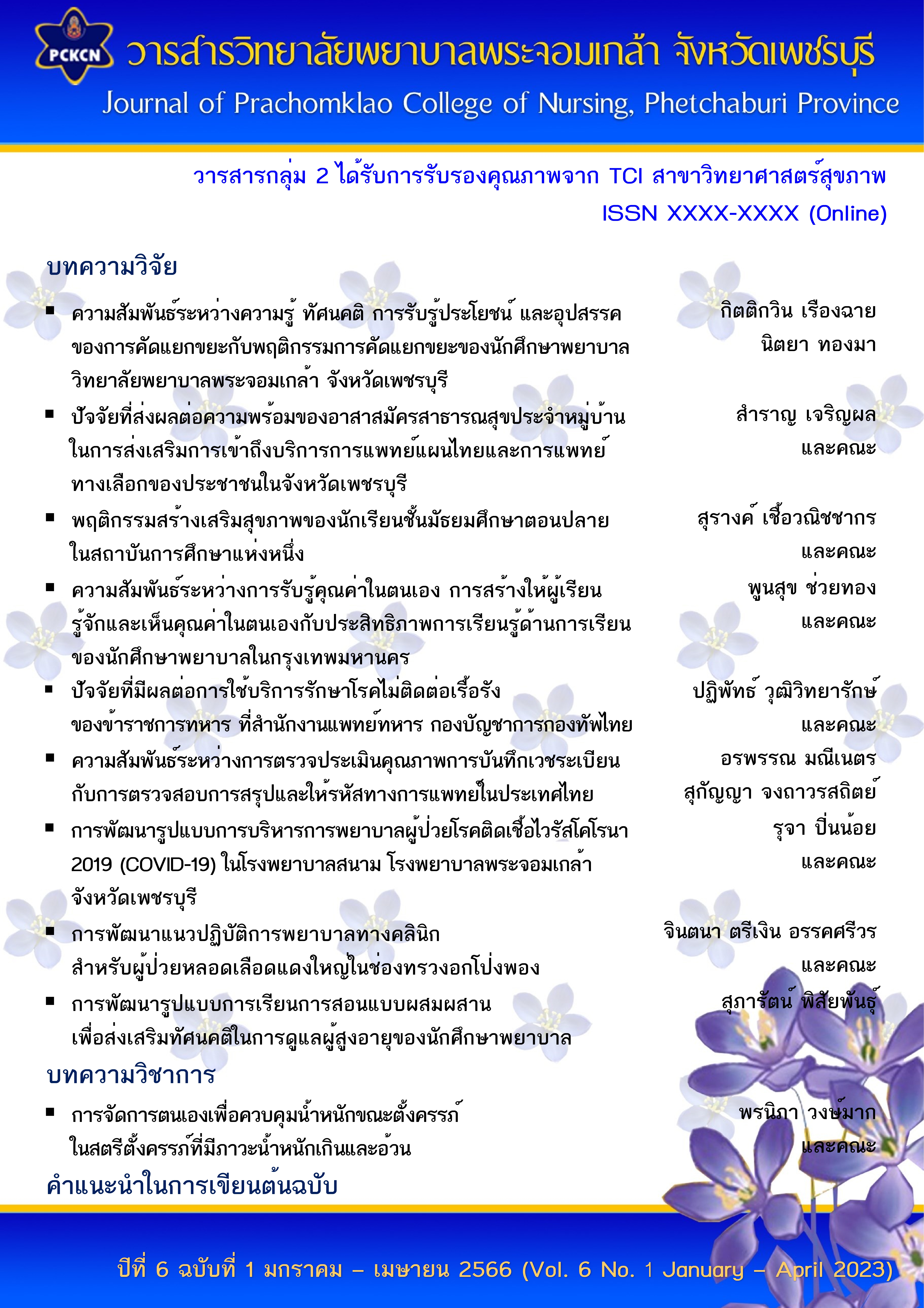ความสัมพันธ์ระหว่างการรับรู้คุณค่าในตนเอง การสร้างให้ผู้เรียนรู้จัก และเห็นคุณค่าในตนเองกับประสิทธิภาพการเรียนรู้ด้านการเรียน ของนักศึกษาพยาบาลในกรุงเทพมหานคร
Main Article Content
บทคัดย่อ
การวิจัยเชิงพรรณนา มีวัตถุประสงค์เพื่อศึกษาประสิทธิภาพการเรียนรู้ด้านการเรียน และความสัมพันธ์ระหว่างการรับรู้คุณค่าในตนเอง การสร้างให้ผู้เรียนรู้จักและเห็นคุณค่าในตนเอง กับประสิทธิภาพการเรียนรู้ด้านการเรียนของนักศึกษาพยาบาลในกรุงเทพมหานคร กลุ่มตัวอย่างเป็นนักศึกษาพยาบาลในกรุงเทพมหานคร จำนวน 260 คน โดยการสุ่มตัวอย่างแบบง่าย เก็บรวบรวมข้อมูลโดยใช้แบบวัดการรับรู้คุณค่าในตนเอง แบบสอบถามการสร้างให้ผู้เรียนรู้จักและเห็นคุณค่าในตนเอง และแบบสอบถามประสิทธิภาพการเรียนรู้ด้านการเรียน มีค่าความเชื่อมั่นสัมประสิทธิ์แอลฟาของครอนบาค เท่ากับ .84, .92 และ .96 ตามลำดับ วิเคราะห์ข้อมูลด้วยสถิติเชิงพรรณนา และสัมประสิทธิ์สหสัมพันธ์เพียร์สัน ผลการวิจัยพบว่า
1. นักศึกษาพยาบาลในกรุงเทพมหานคร มีการรับรู้คุณค่าในตนเอง (M = 77.25, SD = 11.03) และการสร้างให้ผู้เรียนรู้จักและเห็นคุณค่าในตนเอง (M = 35.45, SD = 6.68) อยู่ในระดับปานกลาง และประสิทธิภาพการเรียนรู้ด้านการเรียนโดยรวมอยู่ในระดับปานกลาง (M = 79.07, SD = 15.66) โดยมีคะแนนเฉลี่ยสูงสุดในด้านมนุษยสัมพันธ์ (M =27.78, SD = 6.42) ด้านแนวทางการปฏิบัติงาน (M = 25.66, SD = 5.26) และความรู้ด้านวิชาการ (M = 25.57, SD = 5.03) ตามลำดับ
2. การรับรู้คุณค่าในตนเอง และการสร้างให้ผู้เรียนรู้จักและเห็นคุณค่าในตนเอง มีความสัมพันธ์ทางบวกในระดับต่ำกับประสิทธิภาพการเรียนรู้ด้านการเรียน อย่างมีนัยสำคัญทางสถิติที่ระดับ .05 (r = .21 และ .23 ตามลำดับ)
ผลการวิจัยนี้ สามารถนำไปประยุกต์ในการจัดกิจกรรมส่งเสริมประสิทธิภาพการเรียนรู้ด้านการเรียน โดยการพัฒนาการรับรู้คุณค่าในตนเอง และการสร้างให้ผู้เรียนรู้จักและเห็นคุณค่าในตนเอง
Downloads
Article Details

อนุญาตภายใต้เงื่อนไข Creative Commons Attribution-NonCommercial-NoDerivatives 4.0 International License.
เนื้อหาและข้อมูลที่เผยแพร่ในวารสารวิทยาลัยพยาบาลพระจอมเกล้า จังหวัดเพชรบุรี ถือเป็นข้อคิดเห็นและความรับผิดชอบของผู้นิพนธ์บทความโดยตรง บทความ เนื้อหา ข้อมูล รูปภาพ ฯลฯ ที่ได้รับการเผยแพร่ในวารสารนี้ ถือเป็นลิขสิทธิ์ของวารสารฯ หากบุคคลหรือหน่วยงานใดต้องการนำทั้งหมดหรือส่วนหนึ่งส่วนใดไปเผยแพร่หรือเพื่อกระทำการใด ๆ จะต้องอ้างอิงวิทยาลัยพยาบาลพระจอมเกล้า จังหวัดเพชรบุรี ทุกครั้ง
เอกสารอ้างอิง
Bloom, B. S. (1979). Taxonomy of educational objectives: The classification of educational goals. Handbook/ cognitive domain. Longman.
Cast, A. D., & Burke, P. J. (2002). A theory of self-esteem. Social Forces, 80(3), 1041-1068.
Chunsai, B., & Charoenthanavit, P. (2010). Evaluate the effectiveness of the practicum of students from the Faculty of Science and Technology, Prince of Songkla University, Pattani Campus. Academic Services Journal, Prince of Songkla University, 21(1), 110-137. (in Thai)
Cohen, J. (1988). Statistical power analysis for the behavioral sciences (2nd ed.). Lawrence Erlbaum Associates.
Coopersmith, S. (1981). Self-esteem inventories. Consulting Psychologists Press.
Doulat, A. S. A. (2018). The relationship between self-esteem and academic achievement in the scientific concepts and methods of teaching course among female students of the class-teacher at the University of Jordan. Modern Applied Science, 12(2), 164-170.
Indeed editorial team. (2022, July 22). Learning theory: definition and types of learning theories. https://uk.indeed.com/career-advice/career-development/learning-theory-definition
Kalunyu, P. (2012). Using positively behavioral conclusion activities and group work activities to develop student self-esteem in the course of self development, Suan Sunandha Rajabhat University. Research Institute at Saun Sunandha Rajabhat University. http://eresearch.ssru.ac.th/handle/123456789/217 (in Thai)
Kerdtham, C. (2002). Teaching technique of child center learning. Thai Wattanapanich Printing. (in Thai)
Minanon, R., Parnsumritchok, J., Punyadee, J., Wiwathakamonchai, A., & Kemathad, C. (2013). Factors influence the teaching and learning of nursing students in the principles and techniques of nursing subject, Borommarajonari College of Nursing, Chiang Mai. Nursing Journal, 40(4), 126-138. (in Thai)
Pandey, R. A., & Chalise, H. N. (2015). Self-esteem and academic stress among nursing students. Kathmandu University Medical Journal, 13(4), 298-302.
Pasunon, P. (2013). Sample size determination from Krejcie and Morgan (1970): Approach in quantitative research. The Journal of Faculty of Applied Arts, 7(2), 112-120. (in Thai)
Rungwachira, O., Tangwancharoen, S., & Kiatkanon, K. (2021). Management of learning in modern world to enhance the characteristics of the new generation. Journal of URBU Educational Review (Online), 1(1), 97-106. (in Thai)
Saekuang, P. (2015). Competency, self-esteem, and happiness at work affecting the efficiency of salespersons in Bangkok [Unpublished Master’s thesis]. Bangkok University. (in Thai)
Sharma, P., & Sharma, D. M. (2021). Relationship between self-esteem and academic achievement of secondary school students. Elementary Education Online, 20(1), 3208-3208. https://www.ilkogretim-online.org/fulltext/218-1621787245.pdf
Sunhachavee, A. (2002). Teaching for successful intelligence to increase student learning and achievement. Pearson Education Indochina. (in Thai)
Wajeetongratana, P. (2015). The influence of learning efficiency toward job performance effectiveness on accountants in Nakhonratchasima Province. Journal of the Associations of Researchers, 20(1), 85-94. (in Thai)
Wanchaitanawong, W., Yottavee, W., & Chaiwongnakkapun, C. (2017). Development of awareness in value if life for nursing students. Boromarajonani College of Nursing, Uttaradit Journal, 9(2), 112-127. (in Thai)


